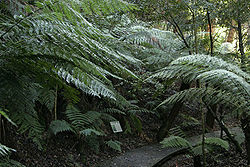Australian National Botanic Gardens
The Australian National Botanic Gardens (ANBG) are in Canberra. They are under the control of the Australian Government's Department of the Environment and Heritage.
The botanic gardens are the largest living collection of native Australian plants.[1] The garen was set up to study and promote Australia's plants. The garden keeps a wide variety of resources for researchers and grows native plants threatened in the wild.
History of the Gardens
The Advisory Council of Federal Capital Territory recommended the setting up of a National Botanic Garden in 1933. A large site for the gardens was set aside on Black Mountain. In September 1949, the first trees were planted by Prime Minister Ben Chifley and Director of Kew Gardens, Sir Edward Salisbury. The Gardens were officially opened in October 1970 by Prime Minister John Gorton.[1]
The Gardens has over 90 ha (222 acres) on Black Mountain. About 40 ha (99 acres) have been used for the Botanic Gardens.[1] Plans for the development of the remaining land are on hold until money is available.
The collection
The gardens is organised in sections; plants are grouped by shared taxonomy or are presented in groupings that exist in nature. More than 5,500 species are cultivated. Displays include:
- Rainforest Gully, featuring plants for the rainforests of Eastern Australia.
- Rock Garden, a display of plants which occur in habitats from the desert to alpine areas.
- Sydney Region Flora, a display of plants found in the sandstone formations of the Sydney basin.
- Mallee Plants, the mallees is the name given to multi-stemmed eucalypts and the shrubs and grasses associated with them.
- Banksias, waratahs and grevilleas (family Proteaceae)
- Callistemon, Leptospermum and Melaleuca (family Myrtaceae)
- The Eucalypt Lawn, features about 20% of Australian eucalypt species.
- Wattles (Genus Acacia)
Research at the Gardens
The Australian National Herbarium is at the National Botanic Gardens. The Herbarium houses the largest collection of pressed, dried plant specimens in Australia. The Herbarium is operated jointly with the CSIRO as part of a joint research facility, the Centre for Plant Biodiversity Research. It is not open to the public. The Australian National Herbarium is participating in the creation of Australia's Virtual Herbarium (AVH), a web based record of botanical information. This includes six million specimen records displaying geographic distribution, images, descriptive text and identification tools.
The Gardens manages several large plant databases, including What's its Name? This is a simple point of access to the more complex 'Australian Plant Name Index' APNI listing all the scientific names ever used for Australia's plants. A large collection of photographs is also available.
The Gardens' library has important collections of botanical books, journals, CD-ROMs and maps. The library is open to students and the public by appointment.
| Wikimedia Commons has media related to Lua error in Module:Commons_link at line 62: attempt to index field 'wikibase' (a nil value).. |
Australian National Botanic Gardens Media
Related pages
References
- ↑ 1.0 1.1 1.2 Castles, Ian (1989). "Year Book Australia 1989" (PDF). Year Book, Australia. Canberra: Australian Bureau of Statistics: 329. ISSN 0312-4746.


